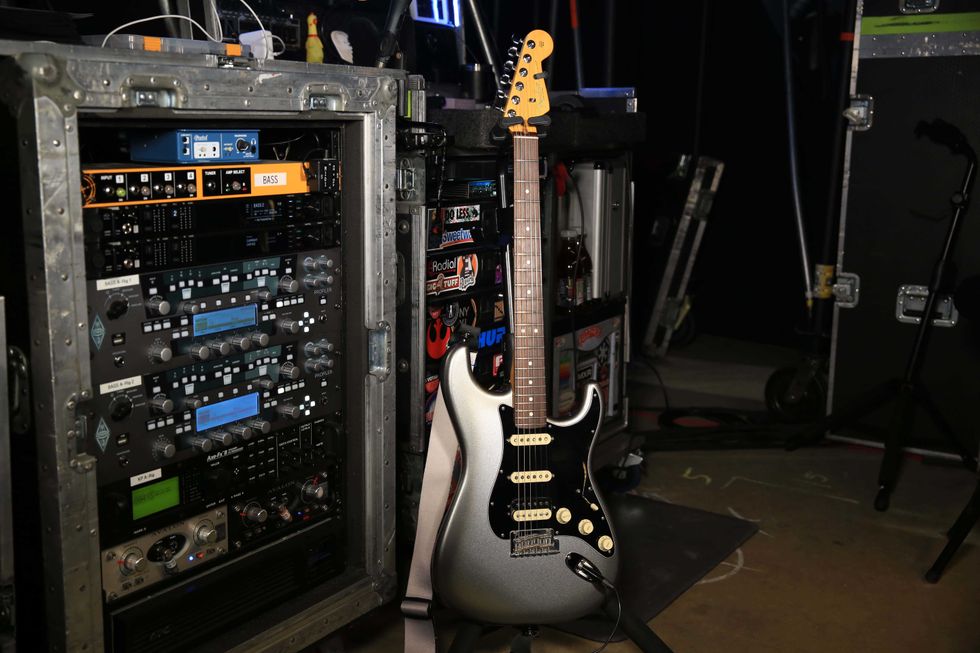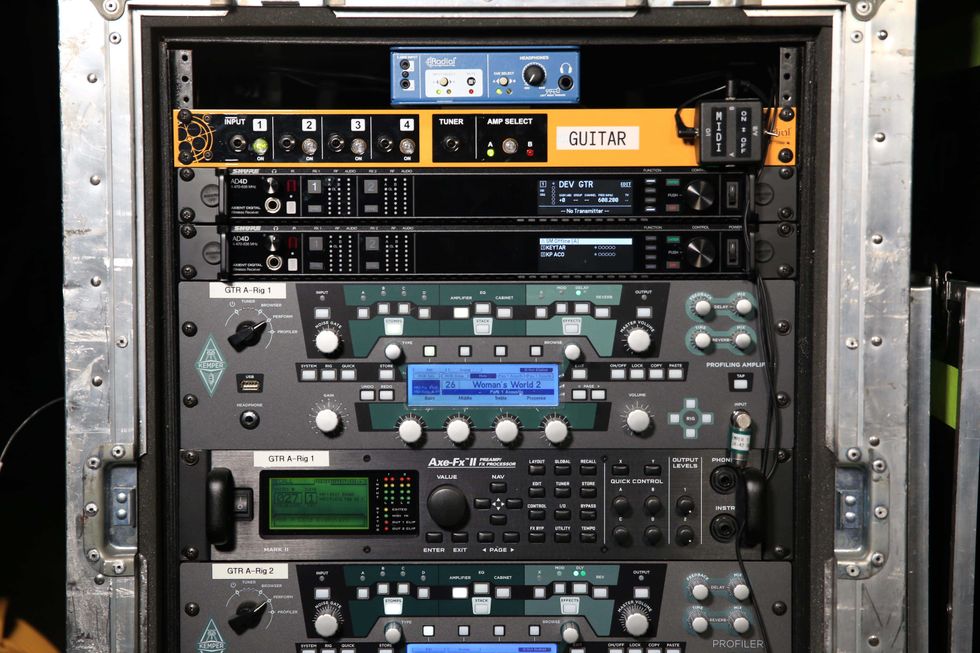There are pedal geeks and effects junkies … and then there’s 311’s Tim Mahoney. Tim’s a master of other-worldly tonal effects who doesn’t travel light when touring. Not even when the Omaha crew jaunts off to Asia or Europe.
Generally, he travels with two boards. The standard board (including over 25 pieces), which goes with him everywhere, and the party board (including eight more pieces) that only ventures out during North American tours. After collaborating with legendary producer Bob Rock on 311’s Uplifter [June ’09], Tim’s pedalboard and overall gear collection expanded. Not only did he get his hands on some vintage compressors, which he’d never favored previously, but he acquired some mid-seventies Explorers and even bought a relic’d Fender David Gilmour Stratocaster.
With such a collection of stompboxes and effects, he’s no different than any other accessory aficionado. He defends his case of P.A.S. (Pedal Acquisition Syndrome) by contending he needs and uses every single effect. Who are we to judge? We just put out an issue completely dedicated to those little tone boxes.
We recently caught up Tim preparing for his upcoming winter tour with 311, and we talked about working with Bob Rock, blending amp tones and why he can’t stop loving the Musitronics Mu-Tron III Envelope Filter.
| Click here to watch Tim run down his rig for PG before a show. |
We all love Ron. It wasn’t anything about his ability or personality that made us go with Bob Rock, but we just wanted to try something new and fresh. Bob was very laid back and easy going. We all learned quite a bit from Bob, too.
What were some of those things you learned from Bob?
As a guitarist, he put me out of my comfort zone, which pushed me to work harder and try new things. He had me record some slide guitar—I’ve never that done on any other album—and I fooled around with a whammy. There was a lot of experimentation during the recording process. When it comes to guitar he has reassuring precision every step of the way that got the best out of me as a player. His calmness and positive attitude make him a rock ‘n’ roll Buddha.
I would never consider myself a pop music fan, but with Bob we really went back to thinking of a pop or catchiness quality within our riffs and songs. He sat in the live room with us every day working out the songs. He’s so good at knowing what good melodies are and when they should be revisited in a song or what songs should have double choruses. As a band, we’d bring individual ideas and then bounce them off each other. A lot of times we’d have a lot of ideas and directions going on at once. Bob really helped us clear up our ideas and make coherency out of our organized chaos.
Overall, what was great about Bob was that he never really forced his power and knowledge on us. He just wanted us to sound better. He told us on day one, “I don’t have a Bob Rock sound, I just want to help you guys make a great album.” He helped us see the bigger picture of the song that maybe we couldn’t see because we were so involved and deep within the project. [laughs] He gave us a very polite kick in the ass.
So did you pick up any cool gear while working on Uplifter with Bob?
Oh man [laughs]… He’s a huge gearhead! He turned me onto some Explorers. I bought at least six guitars during this recording process. For this record, besides my PRS guitars, the main workhorse that I fell in love with was this ’76 Gibson Explorer that I bought thanks to Bob. I did buy a couple of amps while working with Bob, too. I bought a ’63 VOX AC30 and an old Roland Jazz Chorus. We rented one when we were working on Uplifter’s clean tones and once I started playing through it I immediately recognized it as that Metallica-clean from Metallica and we blended that tone in throughout the record.
He had suitcases of pedals lying around the studio. I’ve never seen his collection because it’s in Maui, but anytime we’d come across or talk about some super random pedal, guitar or amp he’d say he owns it. Thanks to Bob, my collection of guitars and amps probably doubled during the whole process [laughs]. I guess you could call it, the “Bob Rock bump” when it comes to gear.
Were there any other tone treats of Bob’s you used?
He did direct me towards a Divided by 13 overdrive pedal that I can’t remember the name of because it was painted funky all over it. I’m not a big compressor guy, but with some of the overdubs he turned me onto a vintage Japanese Boss, an old Ross and an older MXR Dyna Comp.
Did you get Bob to buy or try anything new?
Well, we both bought the new relic’d Fender David Gilmour Stratocaster that came out while we were working on Uplifter. And during the recording process he called down to Jeff at Diamond Amplification and ordered a Spitfire II head because he fell in love with mine. He felt so strongly about the amp that he did an ad with Diamond, but the funny thing is the head that he’s standing next to is actually my Spitfire II head. Another thing I got him stuck on was a late ‘70s or early ‘80s ADA Flanger.
It was just cool that I could share my love and passion for old and new gear with a guy like Bob Rock, especially since I even turned him onto a few new things [laughs].
For Uplifter, how did you dial in the metal tones and the chimey reggae tones?
For both dirty and clean tones, we were always recording four amps. For the clean tones we’d run the two Diamond Spitfire II heads, the ’63 VOX AC30 and the Roland Jazz Chorus all through Diamond 4x12 cabs. We also blended in some parts with Bob’s Divided by 13 head. For the dirty tones, we’d usually run the Diamond Spitfire II and Phantom, a Jose Arrendondo modded 50-watt Marshall, and we’d switch in a fourth head for whatever the mix needed. Each cab had a three mics on it. Every cab had a Shure SM57 and then we’d use two various mics so it began to look like spaghetti [laughs], but we were all quite happy with the results.
What were some more of the guitars you used on Uplifter?
Well, that ’76 Explorer was the workhorse carrying about 90 percent of the load. There’s just something magical about that guitar. It has a fatter neck and we think it was made with leftover parts from the original run of Explorers in the late ‘50s because it’s so heavy and the neck is like a baseball bat. It’s funny because I generally like a wider, thinner neck, but that thing just plays like butter in my hands. We plugged that into the VOX AC30 and I played some reggae stuff through it and it sounded like Marley’s Exodus or Kaya. It was just something really special. I used some of my Gretsches, including a Billy-Bo, but they were only used for an overdub here or an additional texture there. Also, I used that relic’d Fender David Gilmour Strat and a ’95 or ’96 Clapton Signature Strat, too. But for the most part, it was two Explorers and my PRS “Blue” that’s been on almost every 311 recording.
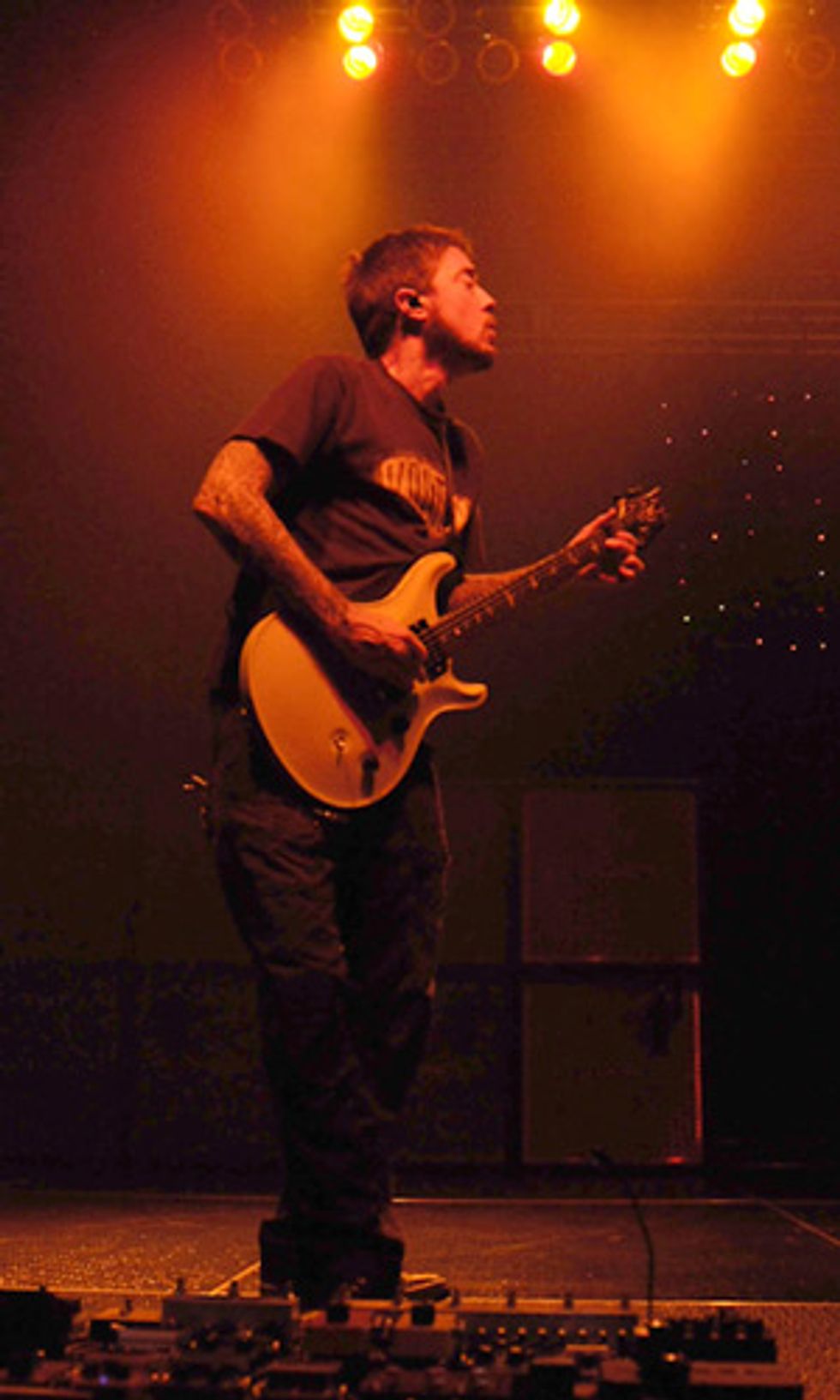 Especially live, you’ve been closely linked to PRS guitars since the mid-‘90s; what first drew you to these guitars?
Especially live, you’ve been closely linked to PRS guitars since the mid-‘90s; what first drew you to these guitars?Growing up, I’d have a Squier Tele and then I’d trade that in and upgrade to a Paul and then I’d trade the Paul for a Strat. And when we finally got signed to Capicorn, I was playing a strat-style Charvel with three single-coils, but I needed something with humbuckers so I could have the contrasting tones. I went into the music store looking for a Les Paul, but I’m a Santana fan and I knew he was playing a PRS, but I didn’t know anyone else that played them or much about the guitars in ’92. I tried one out with a maple top, a bolt-on neck and it was affordable, so I bought it that day and toured with that strat-style Charvel and a PRS CE 24.
Do you still have that PRS
Unfortunately, I don’t. We were out touring in support of Music and we had an RV and my empty VW van that we put in neutral so we could store our gear. We had a bad fuel filter or a hole in the fuel line and while heading back to Omaha the RV caught on fire and we had to run out. The VW was locked and the keys were left in the burning RV so we had to watch all our gear get burnt to the ground. At that point, Bonni Lloyd at PRS immediately sent me a loaner guitar and I thought that was the nicest thing anyone could’ve done and I fell in love with that guitar.
I like PRS guitars because I can do the whole show with one because I can do the chimey reggae stuff, but also pick out some metal harmonics and darker tones I need. Those are my two favorite styles of music since I was a kid of the ‘70s. I grew up listening to reggae and classic rock. I mean, my two favorite guitar players are probably Jerry Garcia and Darrell “Dimebag” Abbott. I don’t know if there’s anything those PRS guitars can’t tackle. They just let me express myself musically in the most well-rounded way. Not only being a killer guitar for me and my tone, they’ve been a great company to work with stemming from that fire back in ’93.
Hit page 2 for Tim's rundown of his pedals, gear philosophy and complete gearbox...
What kind of pickups do you prefer?
I like single-coil pickups for recording, but live they don’t work for me because I need that extra “umphf” that humbuckers have. I’ve never toured with a guitar that has a H-S-S setup [Tim owns a strat-style Tyler H-S-S, but it doesn’t go on tour].
For pickups I’ve used the Seymour Duncan JB in the bridge and the Alnico 2 in the neck, but recently I’ve been digging on these Tom Holmes humbuckers. For my Gibson Les Paul “Burny” copy, I have Duncan Pearly Gates that matches that guitar perfectly. It might just be my guitars that I put them in, but there are only a handful of pickups that have the clarity I like and it’s hard because if you play straight metal you can really dial in your pickup to that tone, but then if you want to switch it over and play reggae it doesn’t really work.
I’m actually working with Seymour Duncan Custom Shop right now to make me a classic PAF-style pickup that I’m dying to hear. I’ve recently loaded the Antiquities into a few of my guitars. I just like it when the pickup isn’t too hot with a pretty even EQ’d output between the two pickups so when I’m switching between clean and dirty or if I’m in the clean channel and I just switch or split the pickups the output levels are similar so my tone doesn’t get out of whack too easily. I like the clarity of a vintage-style lower output pickup, but 10 years ago I was more into the higher output pickups. Now, I like having what’s coming out of the guitar not too hot and kind of mellow so I can use the amp to really dial in the gain. I want the signal out of the guitar to be true and let the amp do the growling.
Why do you feel the need to blend your Diamond Spitfire II and Phantom heads?
Individually those amps are amazing. They are completely unique and can definitely stand on their own, but together they’re unbelievable. The Phantom has some low end growl with more gain and it gets a little bit gnarlier and the Spitfire II acts like a modded vintage Marshall and when I combine them for my dirty signal it fills in nice. We run in-ears and I can really hear that mix and the amps just compliment and fill in what the other lacks or might be missing.
The clean signal is the Spitfire II’s clean and it returns to the power section of another Phantom. So the clean signal is just one clean preamp because they’re not competing where the dirty channels mix and compliment each other. Also, the live setup is in stereo in the sense that each side of the clean has its own delay and I can put two different delay times on it, but everything else is in front. The only thing I really do to the clean channel is in the effects loop I have a Lexicon PCM-60 and PCM-42 that I can get some separation and width from left to right. The dirty channels have the delays in the effects loops, too, so you’re delaying the preamp tone rather than hitting it with a bunch of delays.
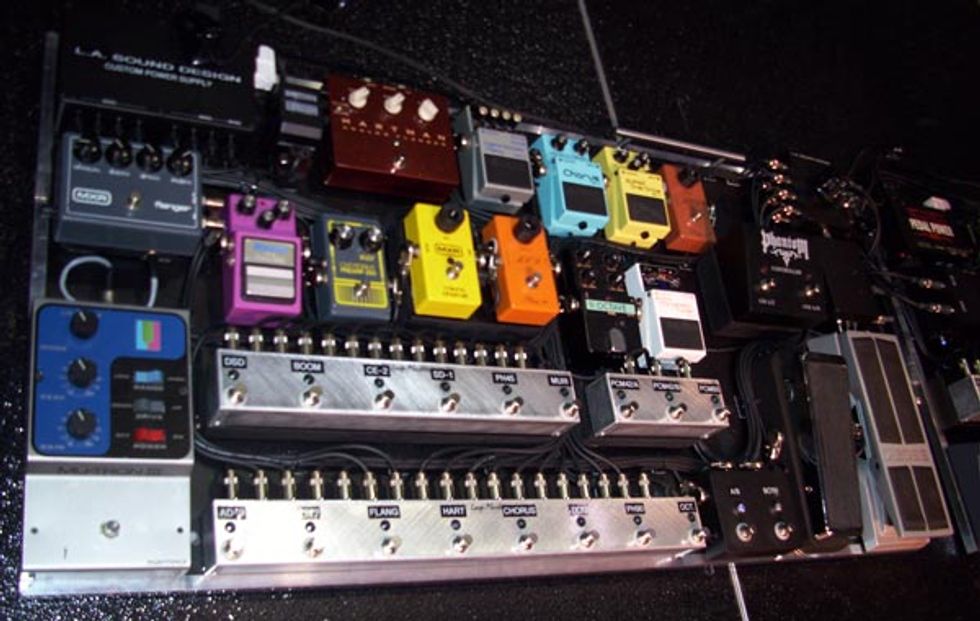
Mahoney's main board
Oh yeah [laughs] … if I had to pick one stomp box as my favorite it’d have to be the Mu-Tron III. I started playing music on a trombone and the envelope filter can dial in some horn-like tones and sounds. I’ve always been a fan of envelope filters dating to the late-eighties when I saw the Grateful Dead and first experimented with acid. I don’t know if that had anything to do with it [laughs]. I just totally dig the expressiveness you can get with it depending on your picking style or attack. You can get it to quack or mellow and fade into the mix. The first envelope filter I had was a Boss TW-1 T Wah and when I found out Garcia used the Mu-Tron III I bought one and realized ‘holy shit, this is my holy grail.’ Unfortunately they don’t make it new so it’s always a hunt for them, but I own four or five of them. I use it pretty heavily on songs like “Amber” and “Champagne,” but Uplifter is the album I probably used it the least just because … [laughs] I don’t think Bob gets the envelope filter like I get it.
On your pedalboard, I noticed you have a lot of pairs of phasers, delays, reverbs and overdrives. What’s the story there?
 I set up my board and organize it with those Loop-Master strips and the first one the guitar goes through before the amps split, which allows me to use it on either the clean or the dirty. For instance, I have a MXR Phase 90 [script logo] that is on this strip and it can be applied to either the dirty or clean channel. After the A/B box and before the cleans, the second set of effects (that are only on the clean amp) I have the old Phase 45 [script logo] because I think it works better with the clean tones and its dialed to a watery, almost-Leslie-ish vibe and for a reggae tone I’ll slow it down quite a bit, too. So the stuff that’s on the clean side like an old Japanese Boss Chorus, delays, flangers and verbs are set up on that side so whatever I’m doing on the dirty amps I can just hit my A/B switcher to get to the clean and have those effects dialed in specifically for that amp and its selected channel. My board looks massive, but setting it up this way with the Loop-Master strips allows me to cut down on tap dancing.
I set up my board and organize it with those Loop-Master strips and the first one the guitar goes through before the amps split, which allows me to use it on either the clean or the dirty. For instance, I have a MXR Phase 90 [script logo] that is on this strip and it can be applied to either the dirty or clean channel. After the A/B box and before the cleans, the second set of effects (that are only on the clean amp) I have the old Phase 45 [script logo] because I think it works better with the clean tones and its dialed to a watery, almost-Leslie-ish vibe and for a reggae tone I’ll slow it down quite a bit, too. So the stuff that’s on the clean side like an old Japanese Boss Chorus, delays, flangers and verbs are set up on that side so whatever I’m doing on the dirty amps I can just hit my A/B switcher to get to the clean and have those effects dialed in specifically for that amp and its selected channel. My board looks massive, but setting it up this way with the Loop-Master strips allows me to cut down on tap dancing.
What are some other effects you like using a lot?
I use a flanger quite a bit on the clean and dirty side. I have an old MXR Flanger Effect for the dirty side that works subtly for the in and out of solos or a transitional spot between songs or jams. On the clean side I use a Hartman Analog Flanger that is like a modern EH Electric Mistress, which is set to a dreamy, chimey vibe like during the bridge in “Hey You.”
Also, I use the two overdrives quite a bit and I use them both because one is a DOD Overdrive Preamp 250 [sits in the strip for both amps] that acts like a clean boost that can just push the levels up and really doesn’t change the tone or sound. “My Stoney Baby” is a clean song, but I’ll use the DOD on the solo just to boost it up a bit and push it louder in the mix. On just the clean side, I have a Keeley modded super overdrive that’s set up as a mid-gain lead tone so I don’t have to take it to the realm of the Spitfire II or Phantom gain stages. I can use the clean channel and that pedal that gets me in between the Spitfire’s clean and gain channel for some boosted clean dirty leads. People probably look at my board and think ‘overkill’ but I use everything on it. We like to change up the set list every night [15 out 20 songs change] and having almost 20 years of songs requires me to have a board that enables me to dial up any tone within our catalog.

So we covered the standard board. What about the Mahoney “party board?”
Tim's Gear Box
|
When you’re working out guitar parts, do you record all your ideas or do you feel that if a riff is good enough it’ll stay with you?
I do a little bit of both. I really do feel the important stuff you do remember and you keep revisiting, but I’ll also be playing something and I’ll spontaneously come up with a cool riff. When that sort of thing happens I just try to get outside myself, get out of the way and hope that I can channel something cool and that sings to our fans. I hate to think that I’m the inventor of a particular riff. All these ideas come from somewhere inside me and outside influences trickle in so I look to my guitar playing as meditation. Just like how a surfer “soul surfs” on his board, I’m soul surfing on the neck of the guitar. To me, creating a song or solo is like chipping away at a sculpture because something eventually surfaces and it is usually something you had no intention of doing or no idea that it was in you.
When something does arise, it’ll start by getting looped into the Boomerang. And if that’s cool, I’ll record that into my iPhone or other portable device that ultimately gets laid into my studio computer where I’ll log it and put it in my ideas or riffs folders because I have a vision for them and I’ll bring those files when I meet with the entire band at some point. So as much as it sounds like I’m organized, I always have riffs floating and reemerging in my head that ultimately get worked into a song.
On Uplifter, “Golden Sunshine” was like that. I’d been playing this riff for years and messing with the chord changes. I couldn’t stop playing it and the guys heard it and the song finally just clicked. The chord arrangements and riff fell into place seemingly out of nowhere. For me, every song comes together in its own, natural process. The Boomerang and mini recorders really help me revisit ideas and riffs that at one point don’t click. They’ve saved some pretty cool stuff from being lost.
With such an array of guitars, amps and effects, what is your philosophy on gear?
You know, I’ve never really been into brands, eras or even years of production when it comes to gear. My motto is “if it feels good, sounds cool and can help bring new ideas or funky tones, I’m all for it.” Being a guitar player you can find new pedals, amps or guitars to motivate ideas and help fine tune and express your voice as a guitarist. I’ll play anything that feels right, but I do prefer mahogany-bodied guitars. To me, maple top guitars are too bright. In a few years, my back may not agree with my ears, but I just love its tone.
I’ve learned over the years that I do prefer older guitars because the ones made with mahogany are from much older and aged wood, while the newer guitars that have mahogany bodies are made from newer woods that are either farmed or just haven’t matured tonally. However, it won’t stop me from playing or trying one out. There’s no rule for gear or guitars, it’s about where your tastes and voices as an artist lie and what particular sounds or tones call to you.



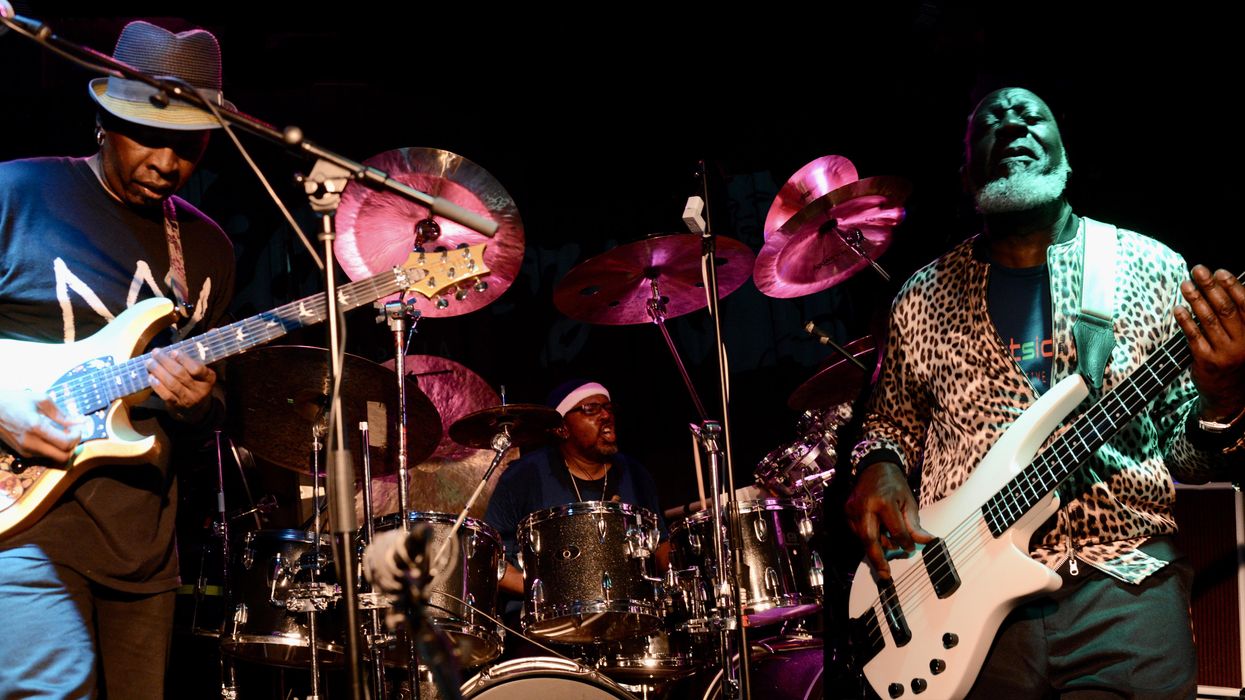


![Rig Rundown: AFI [2025]](https://www.premierguitar.com/media-library/youtube.jpg?id=62064741&width=1245&height=700&quality=70&coordinates=0%2C0%2C0%2C0)












 Shop Scott's Rig
Shop Scott's Rig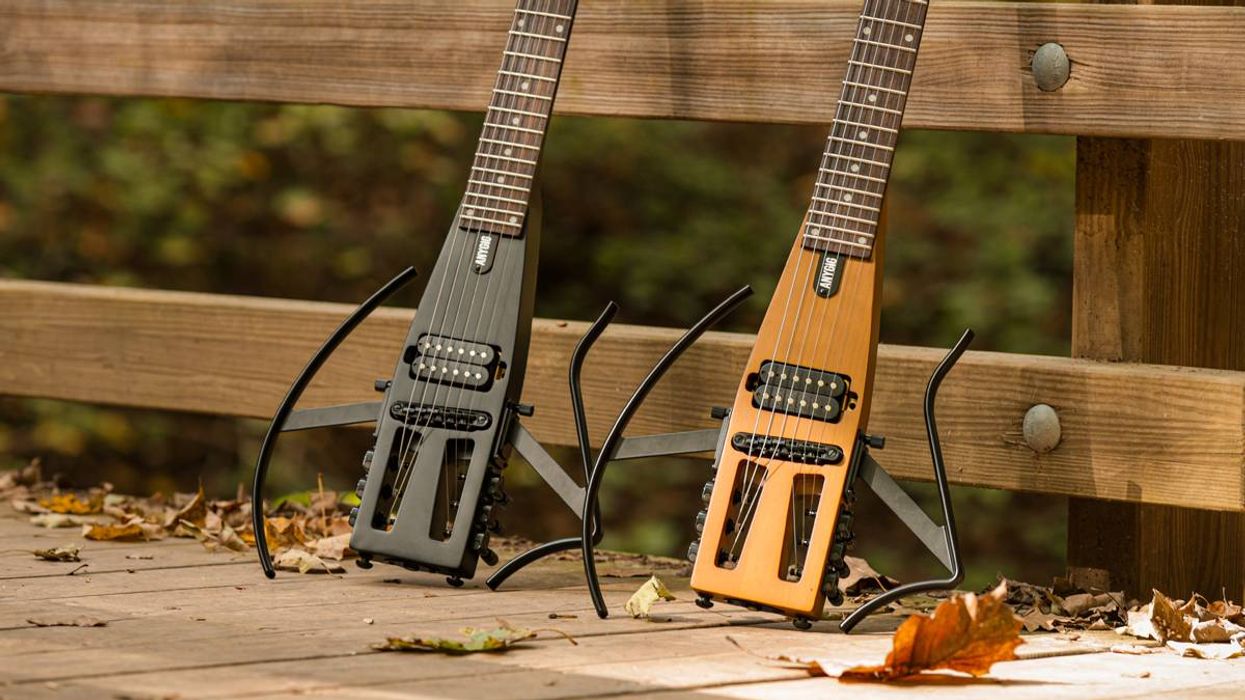
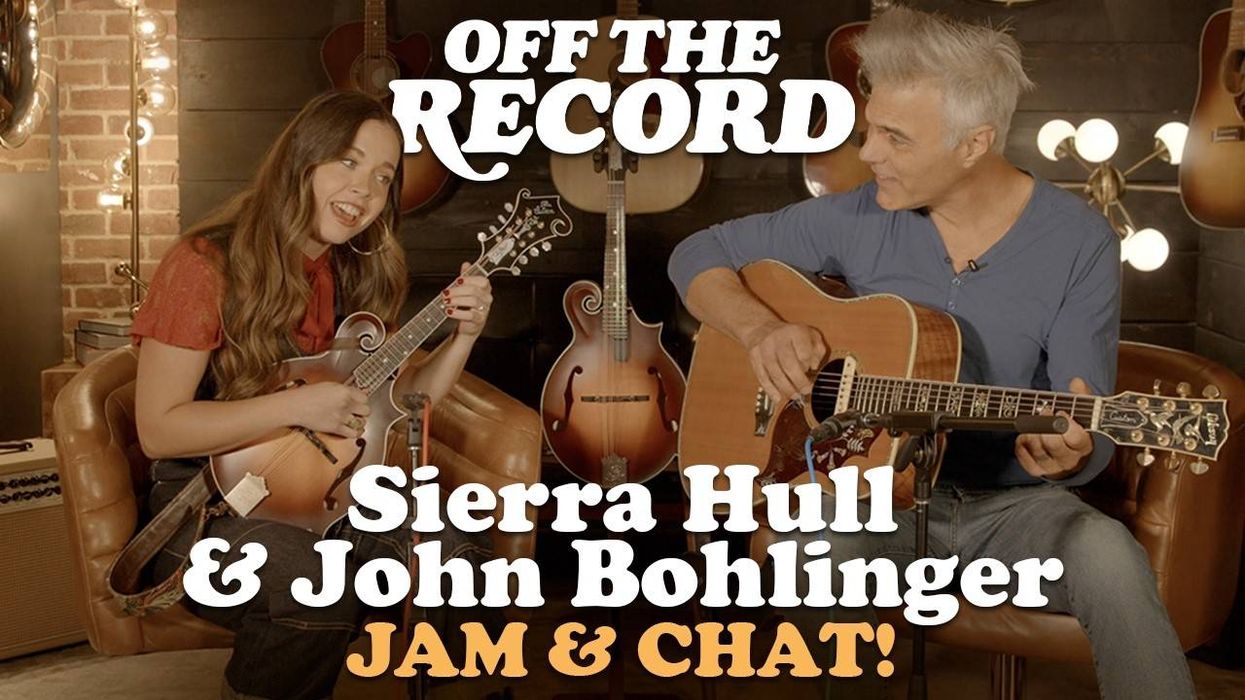
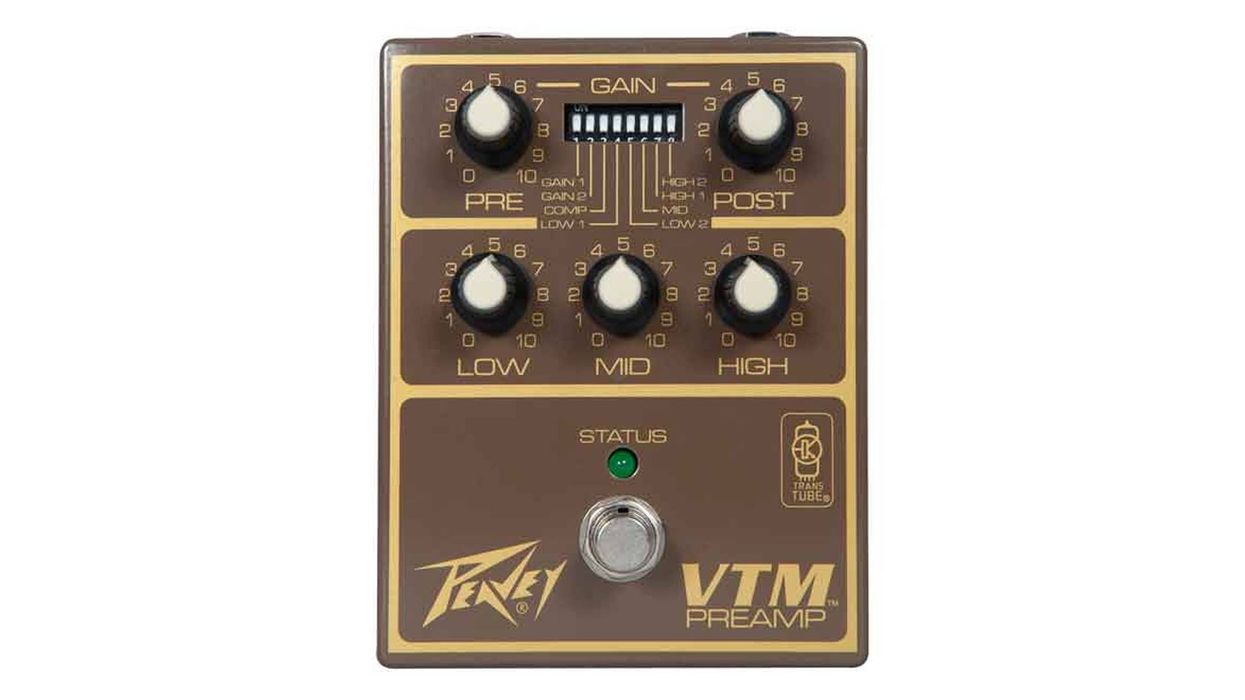
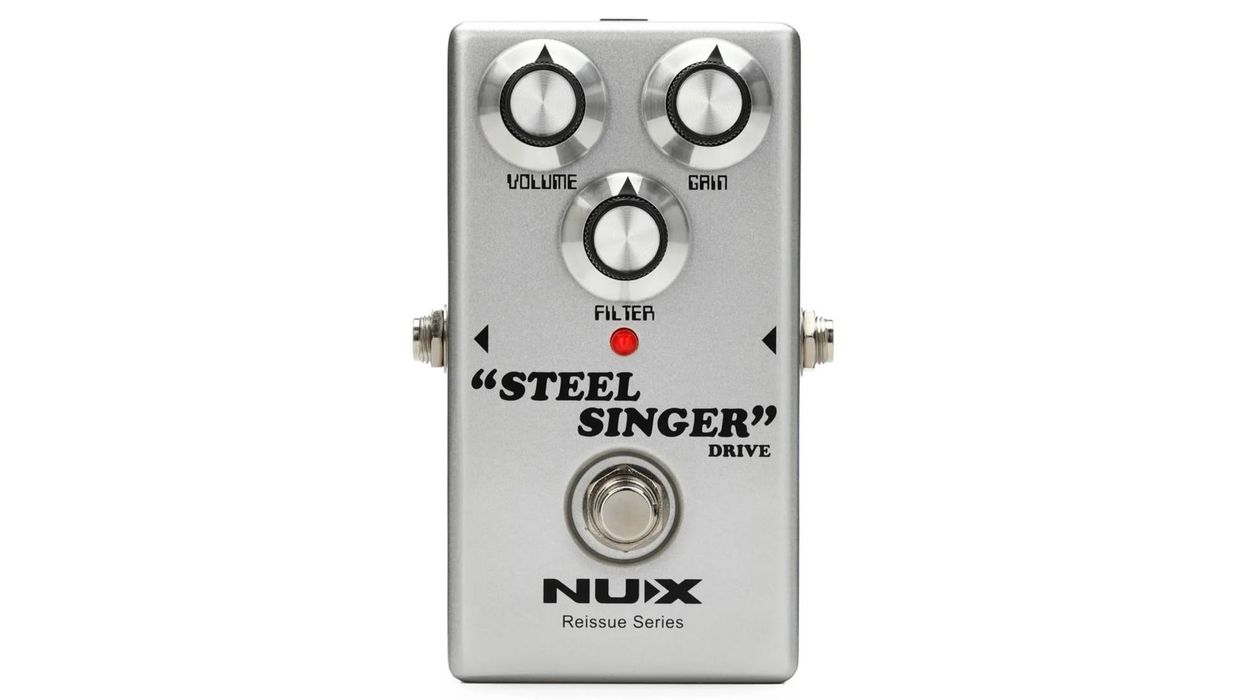
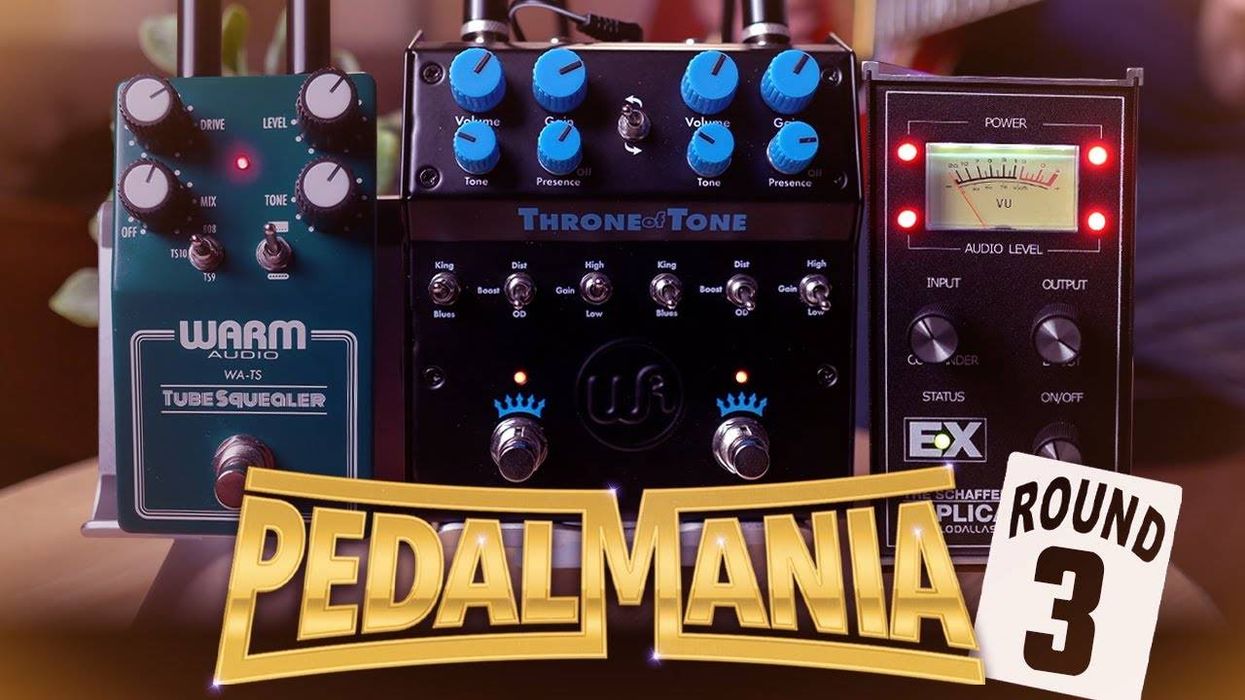









 Zach loves his Sovtek Mig 60 head, which he plays through a cab he built himself at a pipe-organ shop in Denver. Every glue joint is lined with thin leather for maximum air tightness, and it’s stocked with Celestion G12M Greenback speakers.
Zach loves his Sovtek Mig 60 head, which he plays through a cab he built himself at a pipe-organ shop in Denver. Every glue joint is lined with thin leather for maximum air tightness, and it’s stocked with Celestion G12M Greenback speakers.












![Devon Eisenbarger [Katy Perry] Rig Rundown](https://www.premierguitar.com/media-library/youtube.jpg?id=61774583&width=1245&height=700&quality=70&coordinates=0%2C0%2C0%2C0)
